The main difference between a moped and motor scooter is the use of pedals on a moped, and the ability to ride or pedal the moped like a bicycle. The pedals on a moped are used to transfer human energy to propel the moped forward just like a bicycle. Both the moped and motor scooter have a motor, but the scooter has no pedals. The word "moped" is simply a shortened version of joining the two words "motor" and "pedal." Often times you will see a scooter dealership label scooters as mopeds. I believe these dealerships know the difference, but the mislabeling is for internet marketing reasons. Unfortunately it leads the public to believe a moped is a scooter and vise versa. Do a search on YouTube for "mopeds" and you will see quite a few mislabeled scooters. Also some state laws lump scooters and mopeds together under engine size, which leads to more confusion.
Mopeds and many scooters have an engine size under 50cc, but it is common to find scooters with a larger engine. A 150cc engine is a common size for many scooters, and the size can go up as high as 650cc like the engine used on the larger Suzuki Bergman scooter. Most mopeds, if not all, are powered by a 49cc two stroke engine. Most scooters now days are powered by a four stroke engine. This makes four stroke powered motor scooters more fuel efficient and quieter, and easier to comply with EPA or Euro standards. However, two stroke engines tend to produce more horsepower per displacement than a four stroke engine, and have a unique sound all their own. Lubricating a two stroke engine requires mixing motor oil and gasoline together. Most moped's come with a container for motor oil, and mixing the motor oil with gasoline is done by a system called oil injection. However, many used mopeds have the oil tank removed and injection system disabled, so it is up to the rider to mix motor oil and gasoline together before fueling up. This can be a messy and smelly job. Scooters with a four stroke engine have the added benefit of not requiring motor oil to be mixed with the fuel.
Most mopeds have a top speed of 25 to 30 mph, but there are mods out there that can boost top speed closer to 40mph. Most 49cc motor scooters have a top speed of 40 mph, and a 150cc scooter can reach 60 mph. Any scooter larger than 150cc is easily capable of freeway riding. Mopeds and motor scooters using a 49cc two stoke or four stroke engine get close to 100 mpg
Most mopeds and all scooters have a step through type frame, low seat height and a standard riding position, but some mopeds have a frame with a main pipe or backbone making them look similar to a motorcycle. The step through type frame makes it easy for a rider to mount and dismount a scooter or moped, and gives the bike a lower center of gravity, which make's motor scooters and mopeds easier to handle than a motorcycle. While riding, a rider on a moped places their feet on the pedals, and a scooter rider places their feet in front of them on a flat platform, which is part of the scooter body.
Motor scooters usually have a smaller wheel size than mopeds, and its common for scooter wheel's to have a rim diameter of 10, 12 or 13 inch's, giving the motor scooter a lower seat height and lower center of gravity than a moped. However, there are exceptions. Piaggio manufacturers several scooters with a front wheel having a rim diameter of 16 inches, and Yamaha built the Yamaha Chappy moped from 1973 to 1996, and it had small wheels like a scooter making it look more like a scooter than a moped, but unlike a motor scooter it had pedals for pedaling. A smaller wheel size can make a bike more sensitive to steering, which is usually a good thing when traveling at lower speeds through congested traffic, but it can cause a rougher ride and make the bike less stable at higher speeds.
Scooters have more storage area than mopeds. Almost all scooters have a large storage area underneath the seat, and on larger scooters this area can hold a full face helmet and more. Scooters will also have bag hooks, located in the area where you place your feet, for attaching grocery bags or a purse to. Some scooters have a glove box located near the front for storing small items. One drawback i noticed with the 50cc and 150cc Chinese scooters is when a full face helmet is placed in the under seat storage area, you can't quite get the seat to close. Why the Chinese didn't add a little more room is beyond me. If you plan to use your motor scooter or moped for grocery shopping, than a motor scooter definitely has the advantage.
Both mopeds and scooters have automatic transmissions, eliminating the need to shift or operate a manual clutch like on most motorcycles. Scooters use a CVT or continuously variable transmission with belt drive, and most mopeds will use a centrifugal clutch system with chain final drive. Both systems are proven technologies, but do require periodic maintenance. The chain final drive on a moped requires periodic lubrication, and replacement when they wear out. A scooter final drive belt doesn't require periodic lubrication, but they do require replacement every now and than.
Mopeds have a legal advantage over most scooters. Because mopeds are slower and have pedals, some areas allow riders to use mopeds on the street without needing a drivers license. Legal requirements to operate a moped on city streets are almost always more lax than for a motorcycle or scooter. Some areas allow kids 14 and over to legally ride a moped on city streets. It all depends on your local laws.
Mopeds and motor scooters are very easy to ride and maintain, and they are my first pick for fast transport through a heavily congested urban environment like New York City. Mopeds are not as common now days as scooters, but there are plenty of used one's still around from the moped hay-day of the late 70's and early 80's. Tomos brand mopeds are made in Slovenia, and are still sold in the United States. Scooters are made by almost all the big motorcycle manufacturers except for a few like Harley Davidson and some smaller manufacturers. Suzuki makes a popular line of scooters called Bergman, and Yamaha makes the Zuma and XMAX, and Honda makes the Ruckus, Silver Wing and Metropolitan scooters. There are several discontinued, but popular scooters models on the used market built by the same motorcycles manufacturers. One example is a discontinued, but very popular scooter by Honda called the Honda Helix. I don't think Kawasaki Motors makes a motor scooter that's sold in the United States. There has been a flood of low cost scooters from China over the last decade. Most Chinese scooters have a four stroke 50cc and 150cc engine size and range in price from $500 to $1000. Even though Chinese scooters are sold under several different brand names, they almost all use the same engine design called GY6. The similar design has made it easy to find parts, mods and upgrades for Chinese scooters, so if your scooter does break down, there are always replacement parts available.
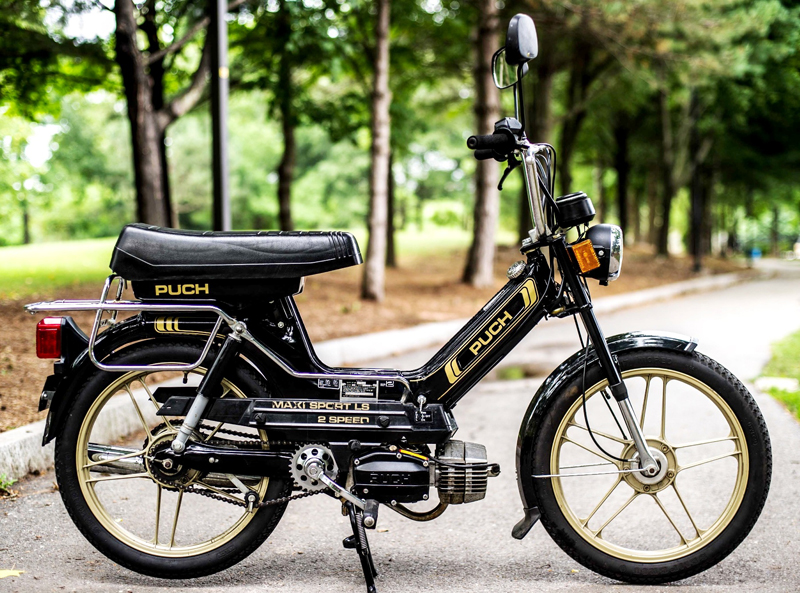
This is a 1985 Puch Maxi Sport moped with a step through frame powered by a two stroke engine. Notice the pedals for pedaling.
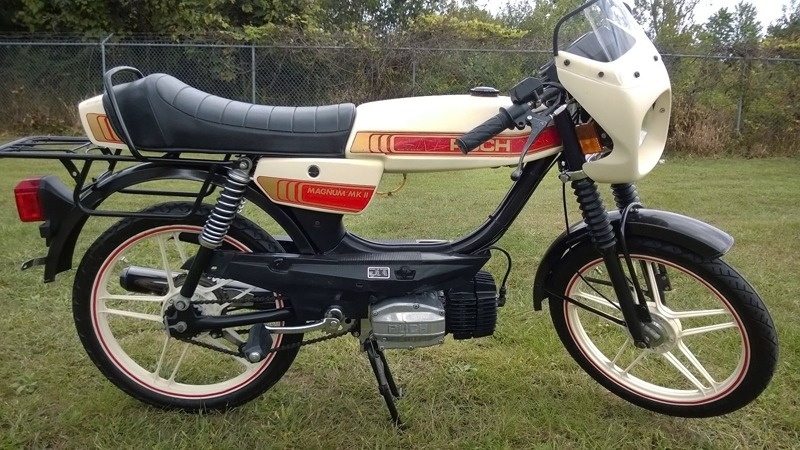
This is a 1981 Puch Magnum moped with a frame main pipe making it look more like a motorcycle, but notice the pedals for pedaling.
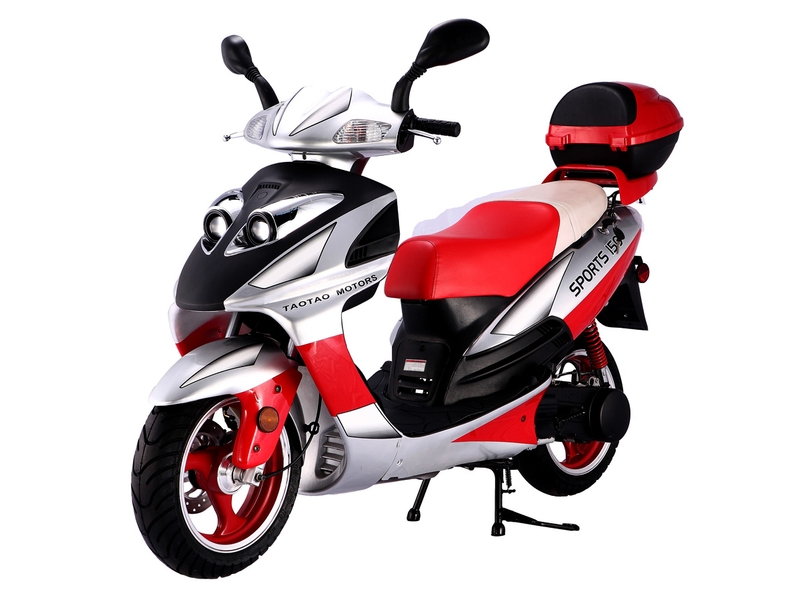
This is a popular Chinese Tao Tao scooter powered by a 150cc four stroke engine.
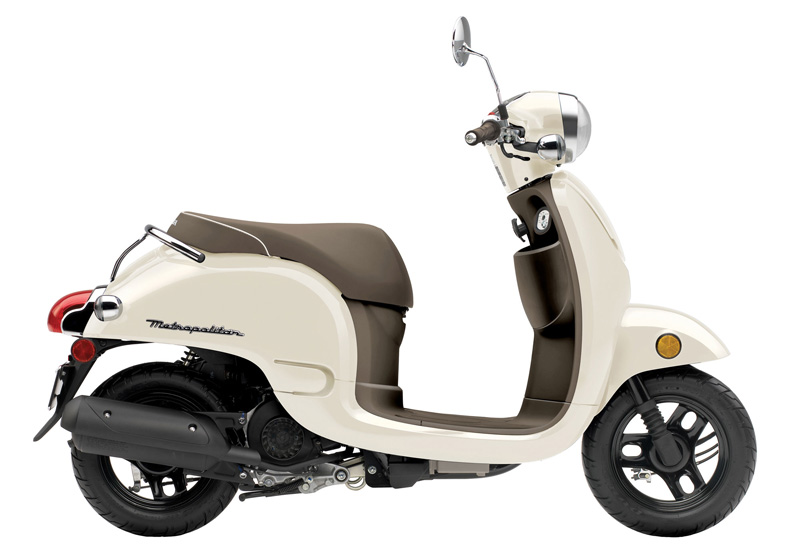
This is a Honda Metropolitan scooter powered by a 49cc liquid cooled four stroke engine.
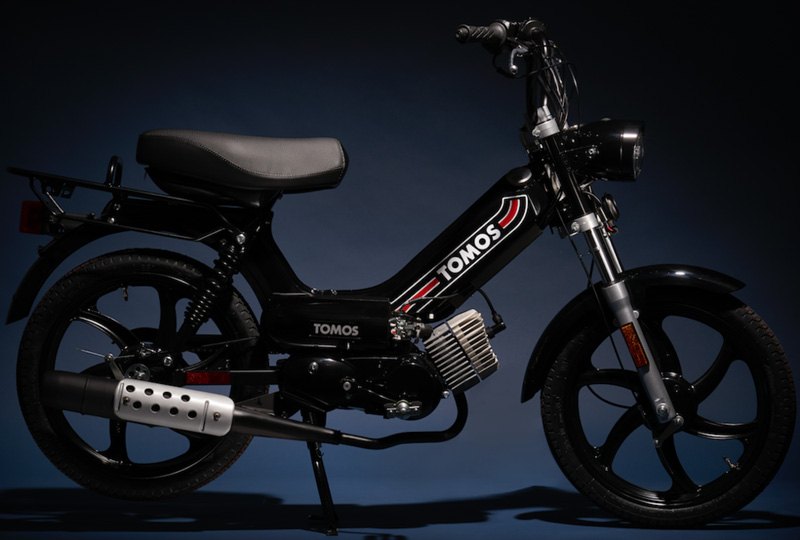
This is a new Tomos moped powered by a 49cc two stroke engine.
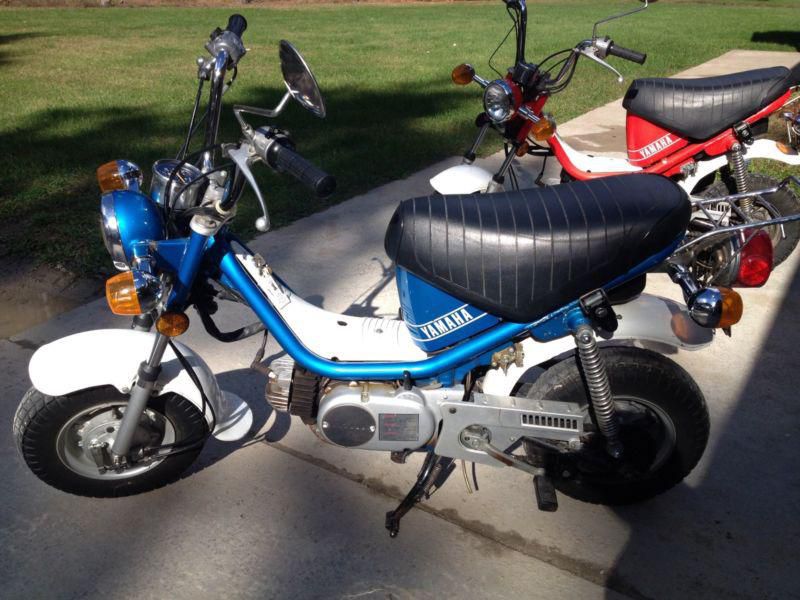
Notice the pedals on this Yamaha Chappy moped and how the small wheels make it look more like a scooter. The pedals can be locked into position making them more like motorcycle foot pegs than pedals. Yamaha manufactured a 50cc and 72cc Chappy, and the 72cc version did not come with pedals. These bikes were also called LB50 and LB80.
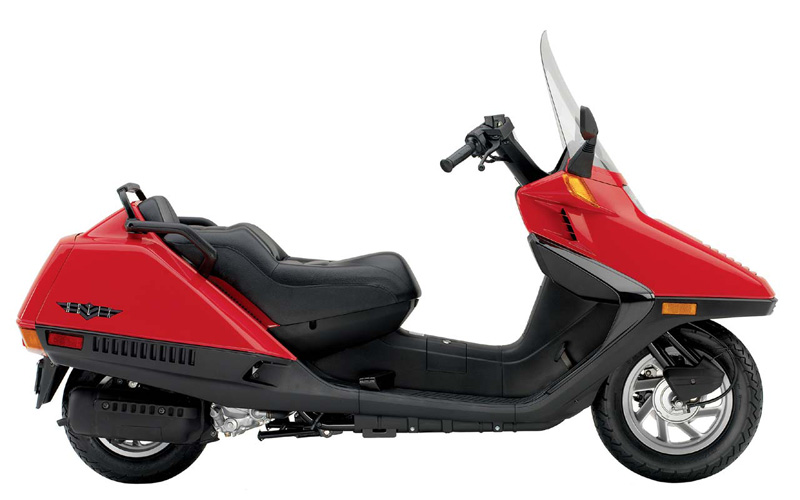
This is a discontinued 2007 Honda Helix scooter. The Helix is also called a CN250 and was manufactured for USA from 1986 to 2007. The Helix is powered by a four stroke, air cooled 250cc engine making it capable of freeway riding.
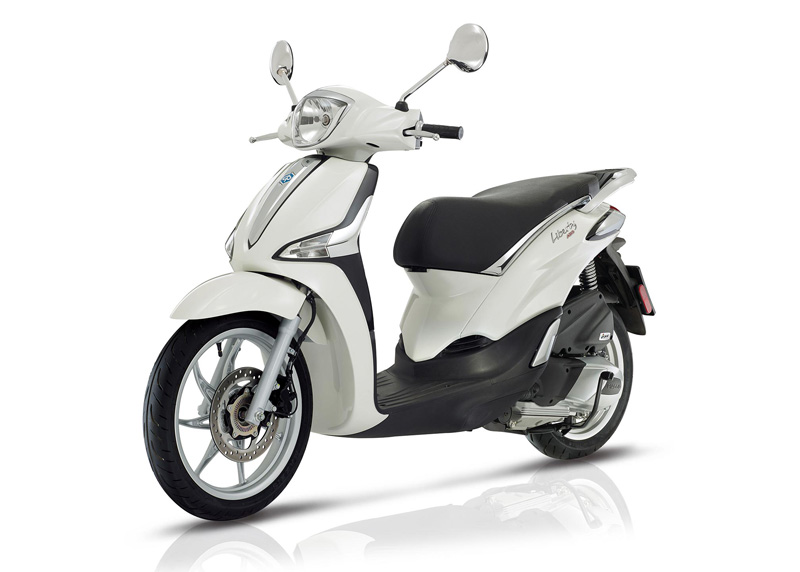
This is a Piaggio Liberty 150 scooter. Notice the larger wheel rim size making it look less like a scooter. Larger wheels contribute to a smoother ride over rough roads and gives the bike more stability at higher speeds.
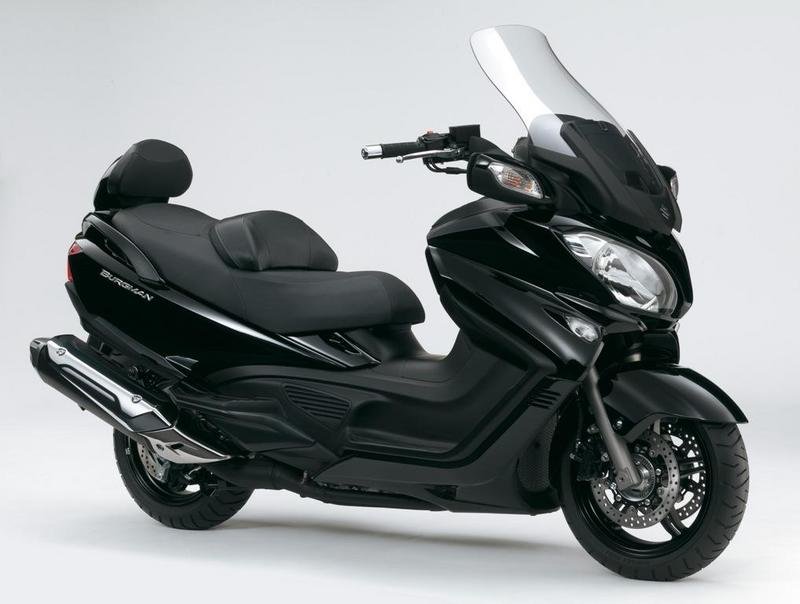
This is the popular Suzuki Burgman 650 scooter. The Burgman scooters are available in 200, 400 and 650cc size versions in the United States, and a 125 version is available in other countries. You can get the 650 Burgman scooter with heated grips, heated seat, different engine/power modes and ABS. I don't think Suzuki offers a heated seat for smaller version Burgman scooters, but you can get heated grips as an add-on accessory. The Suzuki Burgman scooter is pretty much the Honda Goldwing of scooters.
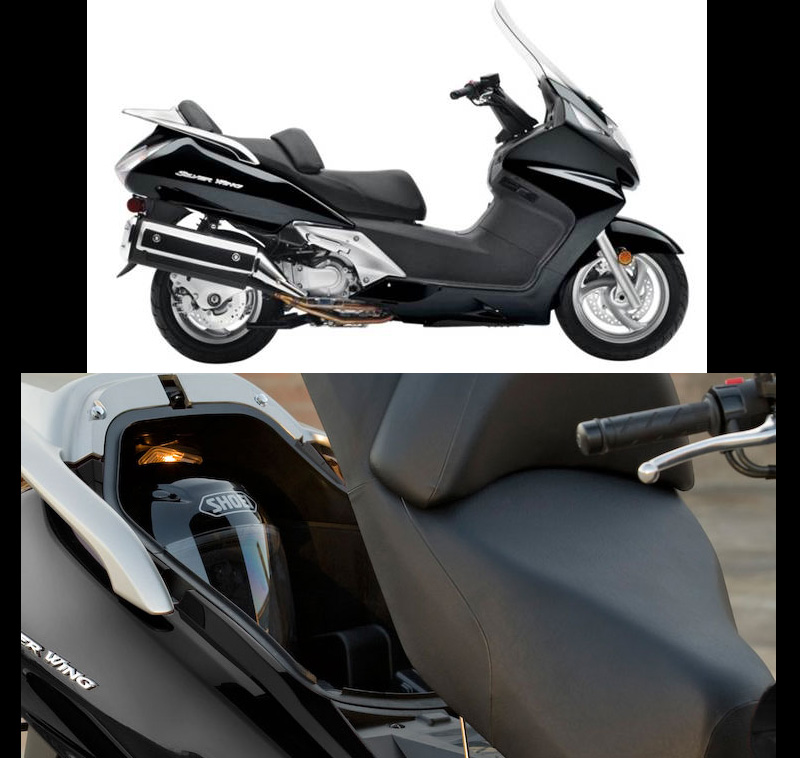
This is a 2018 Honda Silverwing scooter. It's powered by a 582cc parallel twin four stroke engine. Notice the full face helmet sitting in the 55 liter under seat storage area on the bottom. I'm familiar with the limitations of using a motorcycle for grocery shopping, and the options available for adding more storage. It blows me away when I see how much storage there is on larger motor scooters, and even some of the smaller scooters. You can add storage area to a moped, but nothing comes close to the amount of storage area available on a big scooter.